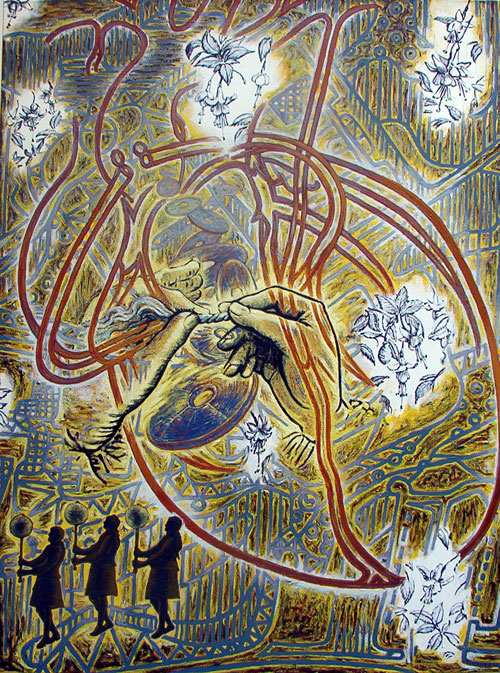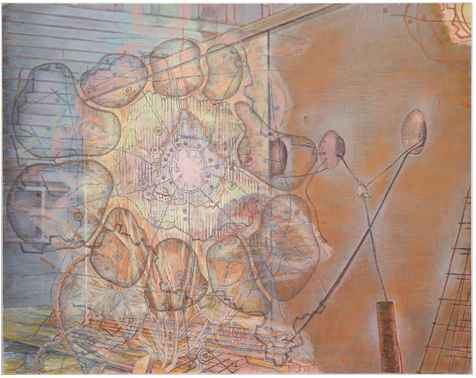
Born in 1956 in Ylitornio, Finland, Pirkko Rantatorikka graduated from the School of the Finnish Academy of Fine Arts in 1982. In her art, personal and universal history becomes one and a purely private experience confronts the prevailing ontological, normative or merely wishful interpretations of how things stand. Equally significant is, how these interpretations linger on in the past and present. More often than not, her artistic practice arises from a private experience, whether a childhood memory, a piece of news read in the daily paper or a view opening from the window of a landing plane. For her, e.g. the war in the Balkans is being represented as a simultaneous experience of sitting at the breakfast table, a child’s reminiscence of war stories told by her father, as well as a geopolitical matter, something the artist’s conscience is compelled to relate to. Thus the artist starts to resemble an optic, through which both grand and small tales focus. In this manner, for example a war does not belong solely to the world of men, or remain a tale only they could tell. On the basis of everyday history, childhood memories, worry felt for the world, and diverse emotive states we all are familiar with, Rantatorikka produced e.g. an extensive series of paintings, the War Stories (Sotajuttuja). Quite tellingly, in 1993 the exhibition was shown in Mikkeli, where the Finnish headquarters was situated during the war.
Although Rantatorikka’s themes are in many cases highly personal, they are not reduced to mere sentimentality. Her memories are not distorted by nostalgia, nor does she emphasise her experiences in a narcissistic way. The starting point of her works may seem rather prosaic. Yet the intellectually attuned artist readily finds a direct – and sometimes surprising – link e.g. to the tradition of the Enlightenment. Denis Diderot, Jaakko Juteini, and the Finnish elementary school system suddenly share the same space. In her hands, a personal experience is always elevated onto a more general level, which is open to us all. Even a less sophisticated viewer will not find it difficult to get into touch with her works.
It does not follow, however, that the multilayered approach so proper to Rantatorikka’s working method would render her works difficult to interpret or conceive. Her palette is a combination of historical imagery, signs, ornaments, maps, and photographs. She deals with common symbols, i.e. the Western cultural conventions of depicting the structures of the world as well as those of the creatures that inhabit it.
Despite the fact that several perspectives or models of interpretation are simultaneously present in nearly all of Rantatorikka’s works, the paintings are never based on a random play of unrelated elements. It is through her workmanship as an artist that the very simultaneity is brought about. Amidst the multitude of materials available to contemporary art, we must not forget that painting is one of the traditions, towards which every artist has to take a stand. At the end of the day, Rantatorikka is a painter, for whom a canvas is not only a meeting place of tales but also a crossroads of the basic problems in painting.
Translation Antti Saarela from Otso Kantokorpi´s article Isot ja pienet tarinat kohtaavat
publication Pinx Maalaustaide Suomessa osa 5 Tarinankertojia WG

|
| "There are powerful emotional charges, expectations and dreams attached to all the stages of building a house and to these homes-to-be – these are the themes that I am trying to observe and visually weave together." Some kinds of house drawings Pirkko Rantatorikka has become known as an artist who ponders and examines her environment and its phenomena precisely, analytically, even critically. The changing structures of our social living interest her as a visual artist and have often given the subject for thematic approaches. In her series of works to be shown at EMMA, Where houses come from, (with the working title Some kinds of house drawings) she is commenting on town planning. She does this by combining and juxtaposing a new neighbourhood in formation and visual elements that expand on and comment on this process of urbanisation. The slow stratification of the works can also be found in the artist’s painting technique. She uses pigment inks to draw with a brush slowly rippling surfaces made up of coloured lines to attain a matt colour effect reminiscent of egg tempera. The tangible starting point for this series of works was the new neighbourhood built on the cliffs and forest clearings of Myllypuro, which continues the new Finnish tradition of wooden towns already familiar to Rantatorikka. The first series of photographs that comments on this upcoming building process was completed by Rantatorikka in 2003–2004. She decided to return to the “site” when construction of the new neighbourhood started in 2010. She has been collecting graphic material straight from the area for years – at all times of day and at all times of the year – which grew to have a significant role in the creation of her series of works. The material incorporated into the paintings is based on elements of nature, art and the built environment, such as the town plans of historic towns, old maps, botanical illustrations, as well as artistic interpretations from different ages. The private experience of the artist becomes, through the creation process, a public one that can be shared. The subject of the series is not so much the new residential area in East Helsinki as generally the relationship between human beings and the environment they live in. Pirkko Rantatorikka (b.1956) is a visual artist from Ylitornio who works in Helsinki. She graduated from the Finnish Academy of Fine Arts in 1982. Rantatorikka has held many solo exhibitions of her work in domestic and international galleries and museums. She has also taken part in group exhibitions around Finland and in international exhibitions in Denmark, France and Germany. Her works can be found in the collections of several museums. |
Page 2 of 2
